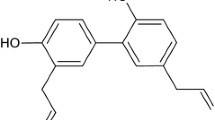Abstract
To clarify the modulation of dragon’s blood on the tetrodotoxin-resistant (TTX-R) sodium currents in dorsal root ganglion (DRG) neurons and explore its corresponding material basis for the efficacy, using whole-cell patch clamp technique, the effects of dragon’s blood and the combined effects of three components (cochinchinenin A, cochinchinenin B, and loureirin B) extracted from dragon’s blood on the TTX-R sodium currents in acute-isolated DRG neurons of rats were observed. According to the operational definition of material basis for the efficacy of TCM established, the material basis of the modulation on the TTX-R sodium currents in DRG neurons of dragon’s blood was judged from the experimental results. The drug interaction equation of Greco et al. was used to assess the interaction of the three components extracted from dragon’s blood. This investigation demonstrated that dragon’s blood suppressed the peak TTX-R sodium currents in a dose-dependent way and affected the activations of TTX-R sodium currents. The effects of the combination of cochinchinenin A, cochinchinenin B, and loureirin B were in good agreement with those of dragon’s blood. Although the three components used alone could modulate TTX-R sodium currents, the concentrations of the three components used alone were respectively higher than those used in combination when the inhibition rates on the TTX-R sodium currents of them used alone and in combination were the same. The combined effects of the three components were synergistic. These results suggested that the interference with pain messages caused by the modulation of dragon’s blood on TTX-R sodium currents in DRG neurons may explain some of the analgesic effect of dragon’s blood and the corresponding material basis for the efficacy is the combination of cochinchinenin A, cochinchinenin B, and loureirin B.
Similar content being viewed by others
References
Chen T, Liao T A. Observation for the curative effects of dragon’s blood capsule for stopping bleeding and relieving pain after exodontia. Hainan Med J (in Chinese), 2002, 13(10): 48
Xiang J L, Zhang L H, Chen R. Studies on anti-inflammation and analgesic effects of dragon’s blood. Lishizhen Med Mater Med Res (in Chinese), 2001, 12(2): 110–111
Liu X M, Chen S, Yin S J, Mei Z N. Effects of dragon’s blood and its component loureirin B on tetrodotoxin-sensitive voltage-gated sodium currents in rat dorsal root ganglion neurons. Sci China Ser C-Life Sci, 2004, 47(4): 340–348
Gold M S, Reichling D B, Shuster M J, Levine J D. Hyperalgesic agents increase a tetrodotoxin-resistant Na+ current in nociceptors. Proc Natl Acad Sci USA, 1996, 93: 1108–1112
Lai J, Gold M S, Kim C S, Bian D, Ossipov MH, Hunter JC, Porreca F. Inhibition of neuropathic pain by decreased expression of the tetrodotoxin-resistant sodium channel, NaV1.8. Pain, 2002, 95: 143–152
Wen D X. Advances in studies on dragon’s blood. Zhong Cao Yao (in Chinese), 2001, 32(11): 1053–1054
Gao Y, Lü X J, Liu Y X, Chen P, Tan H L. Research on material basis for the efficacy of Traditional Chinese Medicine compounds. Chin New Drugs J (in Chinese), 2000, 9(5): 307–308
Huang H S, Ma C G, Chen Z W. Advances in studies on pharmacological effect of flavonoids. Chin J Chin Mater Med (in Chinese), 25(10): 589–592
Meksuriyen D, Cordell G A. Retrodihydrochalcones from Dracaena loureiri. J Nat Prod, 1988, 51(6): 1129–1135
Lu W J, Wang X F, Chen J Y, Lü Y, Wu L, Kang W J, Zheng Q T. Studies on chemical constituents distilled from Dracaena cochinchinensis with chloroform. Yao Xue Xue Bao (in Chinese), 1998, 33(10): 755–758
Tate S, Benn S, Hick C, Trezise D, John V, Mannion RJ, Costigan M, Plumpton C, Grose D, Gladwell Z, Kendall G, Dale K, Bountra C, Woolf C J. Two sodium channels contribute to the TTX-R sodium current in primary sensory neurons. Nat Neurosc, 1998, 1(8): 1653–1655
Greco W R, Park H S, Rustum Y M. Application of a new approach for the quantitation of drug synergism to the combination of cis-diamminedichloroplatinum and 1-β-D-arabinofuranosylcytosine. Cancer Res, 1990, 50(17): 5318–5327
Snyder S, Argenio D Z D, Weislow O, Bilello J A, Drusano G L. The triple combination indinavir-zidovudine-lamivudine is highly synergistic. Antimicrob Agents Chemother, 2000, 44(4): 1051–1058
Song J H, Huang C S, Nagata K, Yeh J Z, Narahashi T. Differential action of riluzole on tetrodotoxin-sensitive and tetrodotoxin-resistant sodium channels. Pharmacology, 1997, 282(2): 707–714
Waxman S G. The molecular pathophysiology of pain: Abnormal expression of sodium channel genes and its contributions to hyperexcitability of primary sensory neurons. Pain, 1999, 6: 133–140
Gold M S. Tetrodotoxin-resistant Na+ currents and inflammatory hyperalgesia. Proc Natl Acad Sci USA, 1999, 96: 7645–7649
Author information
Authors and Affiliations
Corresponding author
Rights and permissions
About this article
Cite this article
Liu, X., Chen, S., Zhang, Y. et al. Modulation of dragon’s blood on tetrodotoxin-resistant sodium currents in dorsal root ganglion neurons and identification of its material basis for efficacy. SCI CHINA SER C 49, 274–285 (2006). https://doi.org/10.1007/s11427-006-0274-4
Received:
Accepted:
Issue Date:
DOI: https://doi.org/10.1007/s11427-006-0274-4




